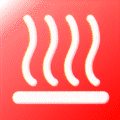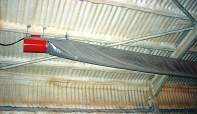
| ||||
W. Tombling Ltd.
Wembley House
Dozens Bank
West Pinchbeck
Spalding
Lincolnshire
PE11 3ND
U.K.


Industrial heaters prevent condensation forming
Condensation forms on a surface when its temperature drops below the dew point of the surrounding air. It occurs mainly on cold solid surfaces, but when warm moist air is cooled by cold air, ‘fog’ forms.
Condensation can be controlled by recirculating the air, which causes moisture on surfaces to evaporate, and by introducing a small amount of heat to counteract the chilling effect of very cold surfaces.
It is important to note that LPG (liquefied petroleum gas) heaters are not suitable for condensation control because they produce 1Kg of water vapour for every 1Kg of fuel burnt.
Activair industrial heaters are perfect for condensation control, they recirculate and warm large volumes of air, without producing water vapour. For efficient condensation control, the total volume of the air space should pass through the heater(s) a minimum of three times per hour.
Activair industrial heaters have been successfully used for condensation control in agricultural crop stores and industrial plant rooms for many years.
Example - condensation control in potato storageIn the case of potato storage warm air above the pile condenses when it comes into contact with the roof forming droplets. Although structural insulation will reduce condensation even the most modern potato stores suffer intermittently.
Preventing condensation is important for three reasons:
Condensation removes moisture from the air which is replaced from the crop. Every litre of condensation is a loss of 1Kg of crop.
Loss of moisture from the crop can affect its appearance and therefore marketability
Condensation on the roof drips back onto the crop, making it susceptible to disease
By installing Activair Ace industrial heaters near to the eaves and Activair perforated polythene ducting running the length of the potato store to distribute the warm air up the roof slope. The roof is warmed and condensation eliminated.
To determine the heater size required for a modern insulated store apply one of the following:
1.5kW of heat per 100 tonne of store capacity.
15Watts per m2 of roof area.
The heaters can be controlled either:
By a thermostat positioned near the roof surface, set to about 2.5C above store temperature.
By a differential thermostat which turns on the heaters when the roof skin temperature falls 1C compared with the air temperature above the crop.
By an store environment control system
Whatever type of control is used, the heaters should be wired so that they are off when the main fan is running.
Running costs will not be excessive, as the fan heaters will operate for very short periods. An approximate estimate of operating costs can be made by multiplying the size of heater in kW by the unit cost of electricity and then dividing by the anticipated running time per hour:
i.e. One 10kW heater, runs for 15 minute in the hour. The unit cost of electricity is 7.64 pence.
Cost Per hour = (10 X 7.64) / 4 = 19.1p/hour
The need for condensation control in potato stores is greatest in the early morning, cheap tariff electricity should be available, reducing operating costs further.
Copyright © 2002/6, W. Tombling Ltd.
